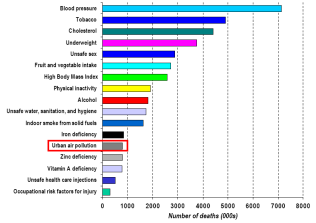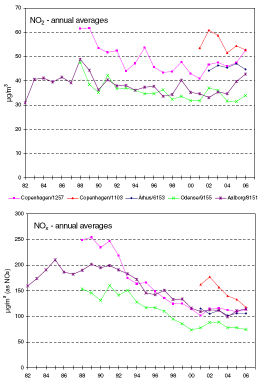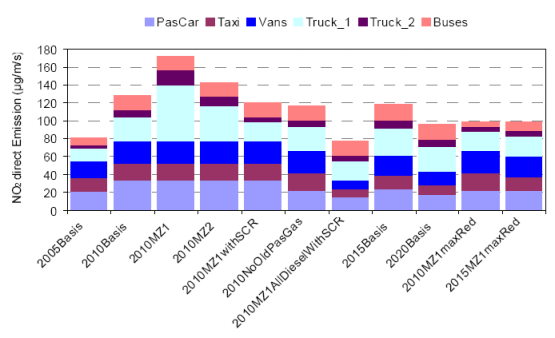|
|
 |
|
|
|
 |
 |
|
|
 |
Research B: Ozone and particle filters
We are concerned about air pollution in our cities, we are exposed to. We speak about concentrations of pollutants surrounding us, sometimes also called "immission". One type of pollution is particulate matter coming from emissions of vehicles in busy streets, from tyre abrasion and sometimes also industries. But also sources farer away, either natural or human made, contribute to the concentration of pollutants.
|
|
Particles are proven to have negative consequences for our health, although it is not really well known how high this risk is and although other health risk as smoking, unhealthy nourishment or too much alcohol have clearly worse impacts, we would like to reduce the risk. One possible measure is the installation of particle filters. This is necessary primarily for diesel cars, because they emit most of the particles.
|
However, it is not always possible to tackle all problems at once. A research effort in Copenhagen tells us why diesel particle filters can increase the concentrations of NO2 again.
The study took place at Jagtvej, a busy street in Copenhagen. Traffic has been observed and counted there on normal weekdays. At the same time NO2, NO and ozone concentrations have been measured. The same sort of analysis has also been made on week-end nights, when the traffic is dominated by taxis.
|
 |
 |
 |
|
1. Worldwide deaths in 2000 attributable to selected leading risk factors. Source: WHO 2002
Please click on the graphs for a larger version.
|
|
 |
 |
|
2. Jagtvej is a busy street in Copenhagen. The monitoring station is located in a so-called street canyon with 18m high buildings on both sides. (on the right side in this photo)
|
|
 |
The taxis are equipped with diesel particles filters (DPF) of the newer generation, so called continuous regeneration traps (CRT, see article: background). The filters are efficient in particle reduction. Therefore, they help to reduce the health risk arising from particles for people living in the vicinity of busy streets. But for the continuous regeneration of the filter more nitrogen dioxide (NO2) has to be generated compared to a car without DPF. The consequences can be directly observed in the streets:
|
|
The taxis emit more NO2 than other diesel cars. And direct emissions of NO2 contribute with 40% to their total nitrogen oxide (NOx=NO2+NO) emissions. For the normal average traffic direct NO2 only contributes with 16% to their NOx emissions. The major fraction in the emissions is nitric oxide (NO), which reduces the ozone level in the city centres. In the years 1995 -2006 the direct NO2 contribution to nitrogen oxides emissions from road traffic increased from approximately 5 % to 18 %.
|
From the long term trend of four stations in Denmark it can be seen that in the 1990s the total amount of nitrogen oxides (NOx = NO + NO2) has been reduced thanks to the introduction of catalysts. But the observed amount of NO2 in the air has hardly changed. One reason for this is that NO2 is a reaction product of NO with ozone and the ozone levels have been constant over the last years. However since about 2004 the NO2 levels start even to increase again. This increase is to a large part attributed to the increase on the direct NO2 emissions as described above.
The study shows that vehicles with CRT-type of diesel particle filters have a high relevance in this balance.
|
 |
 |
 |
|
3. Trends in the NO2 concentrations (above) and total nitrogen oxide concentrations (below) at different urban stations in Denmark. Source: Danish Nat. Envir. Research Inst., Technical Report No. 623, 2007
|
|
|
The National Environmental Research Institute (NERI) in Denmark also modelled different scenarios for the future. How much direct NO2 would be emitted by a car fleet equipped with present standard diesel particle filters, a larger fraction of diesel vehicles and new technologies like Selected Catalytic Reduction (SCR), which would be available for the wider market in the near future.
|
 |
 |
|
4. Modelled direct NO2 emissions under different scenarios for the technical equipment of the car fleet. Source: Palmgren et al., Proceedings of the 2nd ACCENT Symposium 2007
|
|
The results show, that it is hardly possible to reduce direct NO2 emissions below the direct emissions of the present car fleet. Most likely direct NO2 emissions are going to increase. In this case the envisioned future air quality targets for NO2 concentration in the ambient air in the European Union cannot be met with the present standard technologies.
|
Many thanks for scientific advice and reviewing of this page to Matthias Ketzel from the Danish National Environmental Research Institute. www.air.dmu.dk
|
|
 |
|







